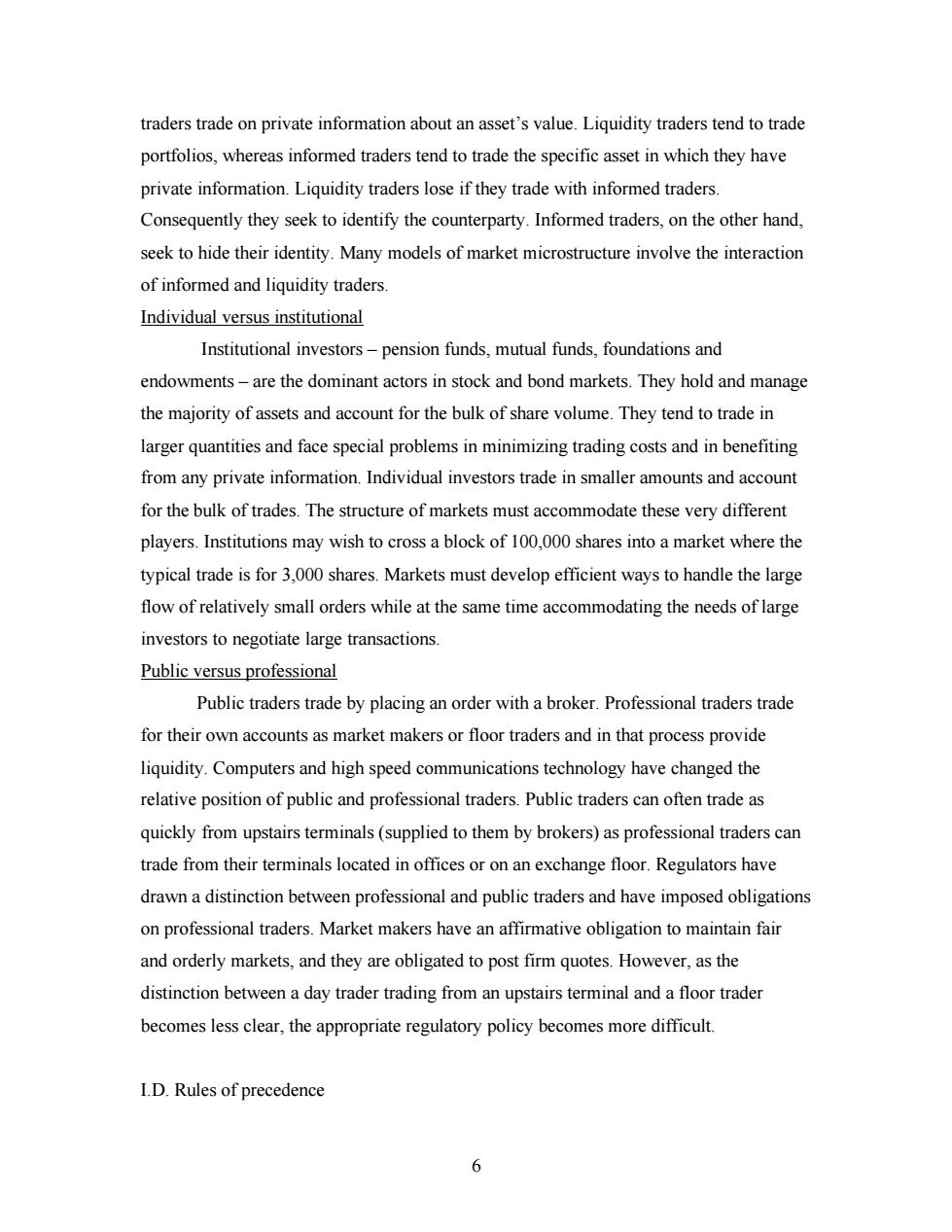正在加载图片...

traders trade on private information about an asset's value.Liquidity traders tend to trade portfolios,whereas informed traders tend to trade the specific asset in which they have private information.Liquidity traders lose if they trade with informed traders. Consequently they seek to identify the counterparty.Informed traders,on the other hand, seek to hide their identity.Many models of market microstructure involve the interaction of informed and liquidity traders Individual versus institutional Institutional investors-pension funds,mutual funds,foundations and endowments-are the dominant actors in stock and bond markets.They hold and manage the majority of assets and account for the bulk of share volume.They tend to trade in larger quantities and face special problems in minimizing trading costs and in benefiting from any private information.Individual investors trade in smaller amounts and account for the bulk of trades.The structure of markets must accommodate these very different players.Institutions may wish to cross a block of 100,000 shares into a market where the typical trade is for 3,000 shares.Markets must develop efficient ways to handle the large flow of relatively small orders while at the same time accommodating the needs of large investors to negotiate large transactions Public versus professional Public traders trade by placing an order with a broker.Professional traders trade for their own accounts as market makers or floor traders and in that process provide liquidity.Computers and high speed communications technology have changed the relative position of public and professional traders.Public traders can often trade as quickly from upstairs terminals(supplied to them by brokers)as professional traders can trade from their terminals located in offices or on an exchange floor.Regulators have drawn a distinction between professional and public traders and have imposed obligations on professional traders.Market makers have an affirmative obligation to maintain fair and orderly markets,and they are obligated to post firm quotes.However,as the distinction between a day trader trading from an upstairs terminal and a floor trader becomes less clear,the appropriate regulatory policy becomes more difficult. I.D.Rules of precedence 66 traders trade on private information about an asset’s value. Liquidity traders tend to trade portfolios, whereas informed traders tend to trade the specific asset in which they have private information. Liquidity traders lose if they trade with informed traders. Consequently they seek to identify the counterparty. Informed traders, on the other hand, seek to hide their identity. Many models of market microstructure involve the interaction of informed and liquidity traders. Individual versus institutional Institutional investors – pension funds, mutual funds, foundations and endowments – are the dominant actors in stock and bond markets. They hold and manage the majority of assets and account for the bulk of share volume. They tend to trade in larger quantities and face special problems in minimizing trading costs and in benefiting from any private information. Individual investors trade in smaller amounts and account for the bulk of trades. The structure of markets must accommodate these very different players. Institutions may wish to cross a block of 100,000 shares into a market where the typical trade is for 3,000 shares. Markets must develop efficient ways to handle the large flow of relatively small orders while at the same time accommodating the needs of large investors to negotiate large transactions. Public versus professional Public traders trade by placing an order with a broker. Professional traders trade for their own accounts as market makers or floor traders and in that process provide liquidity. Computers and high speed communications technology have changed the relative position of public and professional traders. Public traders can often trade as quickly from upstairs terminals (supplied to them by brokers) as professional traders can trade from their terminals located in offices or on an exchange floor. Regulators have drawn a distinction between professional and public traders and have imposed obligations on professional traders. Market makers have an affirmative obligation to maintain fair and orderly markets, and they are obligated to post firm quotes. However, as the distinction between a day trader trading from an upstairs terminal and a floor trader becomes less clear, the appropriate regulatory policy becomes more difficult. I.D. Rules of precedence